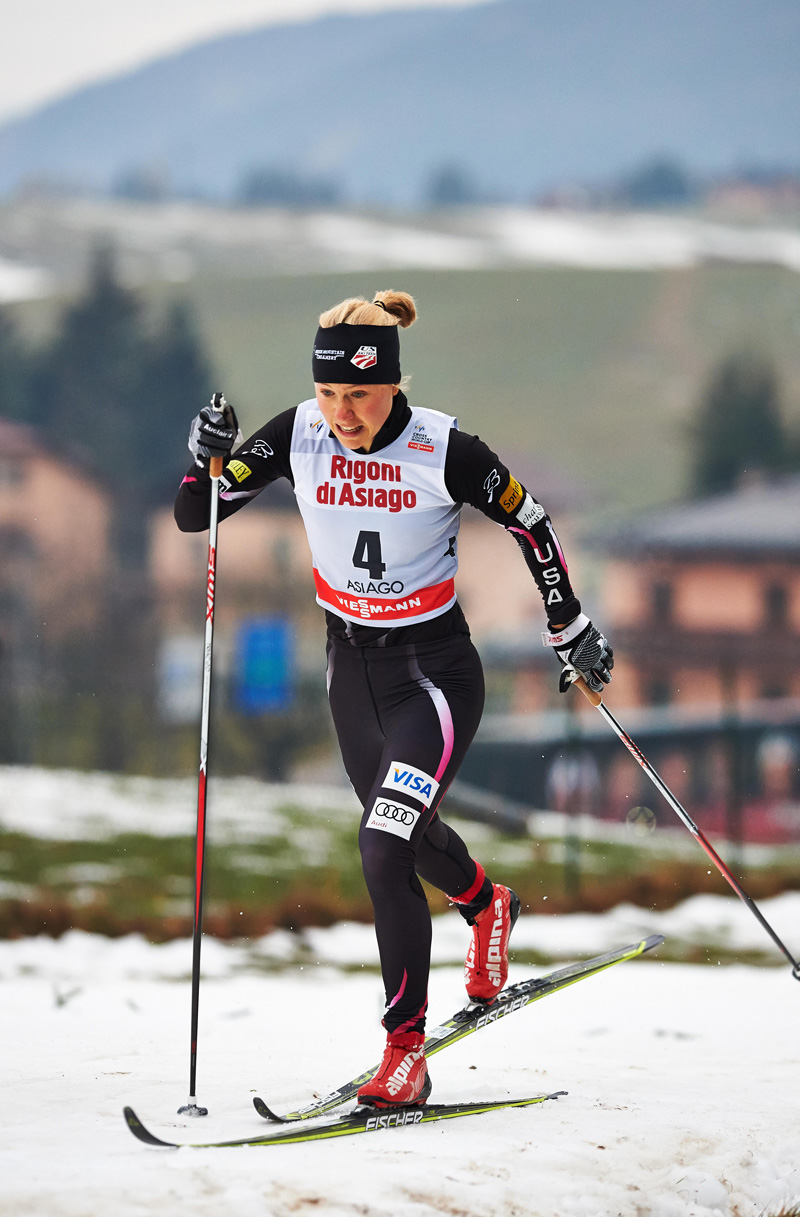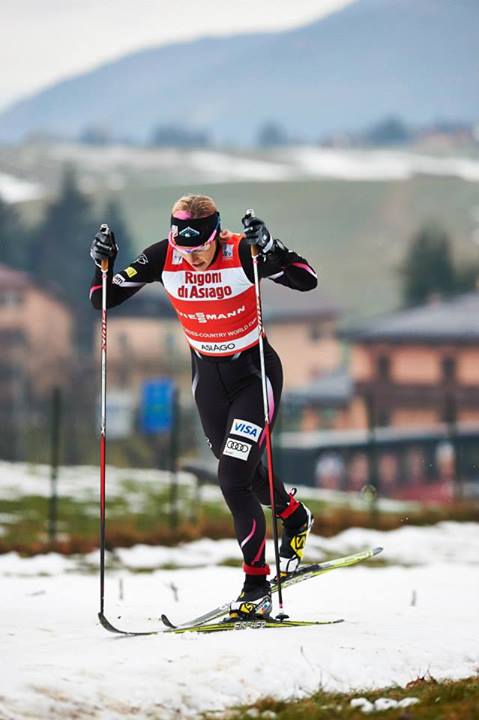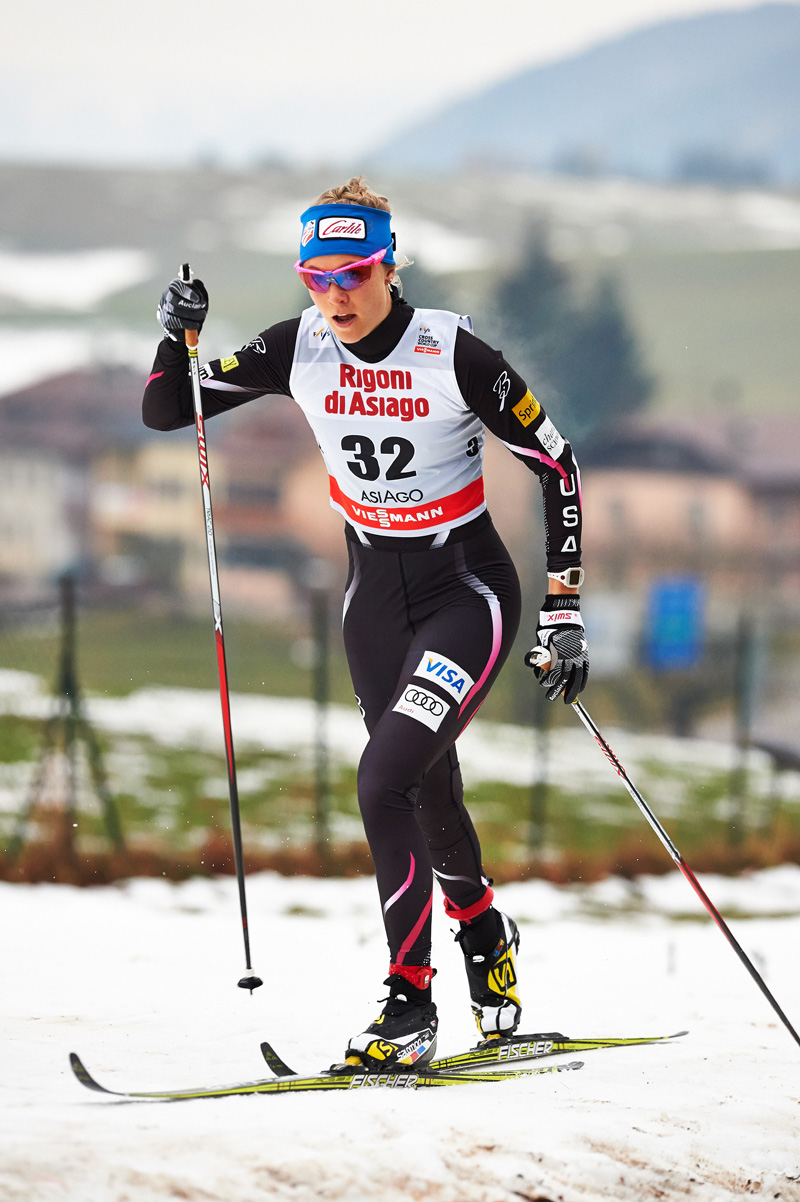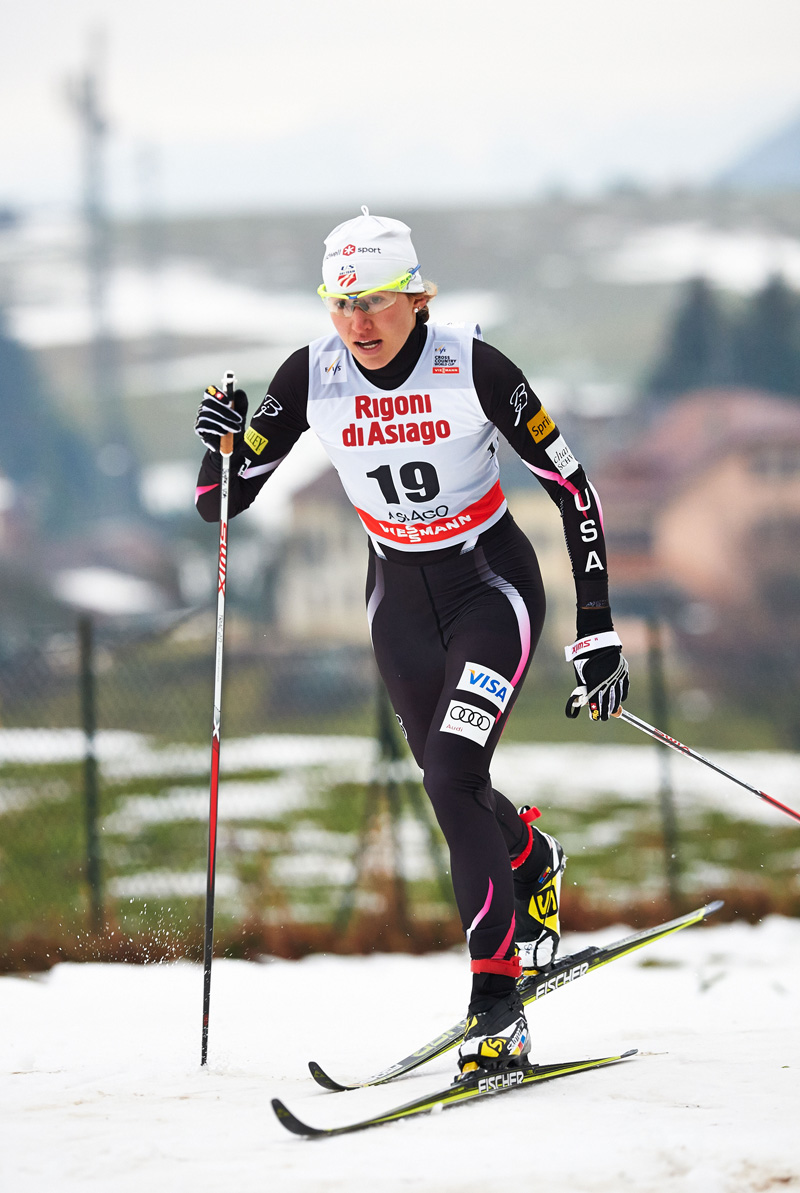
Race after race, the US Ski Team has found success. On Saturday in Asiago, Italy, it was Ida Sargent’s turn.
Sixteenth in her first World Cup of the season, Sargent, 25, has been hardly behind the eight ball. A classic-sprint specialist, she’s only had two classic sprints this season. Saturday marked the second.
The 25-year-old Vermont native started her day with the 21st-fastest qualifying time on the women’s 1.25-kilometer course, holding her own amongst a fleet of Norwegians, most of which double poled on skate skis. On a damp morning with temperatures rising near 40 degrees by the time the heats started, Sargent decided to stride on classic skis – a move that helped her rise all the way to the semifinals.
Third in her quarterfinal behind Norway’s Maiken Caspersen Falla and Slovenia’s Katja Visnar, who won the qualifier and placed second in the quarterfinal on skate skis, Sargent advanced with one of the two fastest “lucky loser” times.

The only North American to make it to the semifinals (teammates Kikkan Randall, Sadie Bjornsen and Sophie Caldwell all advanced out of the qualifiers but not the quarterfinals), Sargent went on to finish fifth behind Poland’s eventual-winner Justyna Kowalczyk, who took first. Sargent placed 10th overall for her first top-10 of the season and second-best classic sprint of her career.
“Today was fun and a good confidence booster,” Sargent wrote in an email. “I had felt like my fitness has been good but the results were not there so it feels great to sneak back into the top ten.”
Looking around at some 63 other women in the field, she noticed that several raced the qualifier on skate skis. While double poling a relatively flat course isn’t uncommon in men’s sprints, it is in women’s – at least until now.
Sargent and the rest of the U.S. women’s team opted for classic skis. While most of the USST members tested double poling on skate skis Friday (and all four of the U.S. men did the same racing Saturday), U.S. coach Matt Whitcomb said that it wasn’t the best option for their women.
“Honestly as a team, I don’t think we’re quite there,” he said on the phone. “It might have exposed a little bit of a weakness or an opportunity. I don’t think as a team our women are confident enough or strong enough on that course. … It’s not something we can look at and say, ‘Yep, for sure,’ like Norway did today.”
While the men’s classic-sprint course will be entirely different at the Sochi Olympics in February, the women’s course shares some similarities with the one in Asiago. According to Whitcomb, both start with climbs and ended with descents. But there’s a good chance the women won’t be double poling the hills in Sochi, Russia.
“I prefer when everybody has to classic ski,” Whitcomb said, adding that Saturday’s double-pole element made it interesting. “It introduced sort of an unusual element of strategy that you don’t usually see. It’s a great course, rolly through the trees; it flows reasonably well.”
He was pleased to see his athletes “hitting their classic stride pretty well,” with good skis on a tricky waxing day. Sargent hung with the best of them, including Visnar, finishing just 0.18 seconds behind the Slovenian in the quarterfinal. Falla finished first in 3:10.5 for the second-fastest quarterfinal of the day, and Sargent was 2.06 seconds back in third.
Falla went on to place third in the final behind Kowalczyk and Finland’s Anne Kyllönen, who notched her first World Cup podium in second.
After what she described as a “horrible start” to her quarterfinal, Sargent was happy with advancing in third.
“I was just asleep on the line and everyone else took off so fast and I was left way behind,” she wrote. “I was able to move up on the next two hills and was in second going into the final stretch but Visnar who was on skate skis got me at the line. I needed [the race] to be just a little shorter.”
As she watched the four other quarterfinals, waiting to see if her time was fast enough while prepping just in case, Sargent explained she was excited to make the cut.
“In the semifinal I had a horrible lane on the outside and got stuck with nowhere to go,” Sargent explained. She tried to get in better position by jumping behind Finland’s Aino-Kaisa Saarinen, but skied on Saarinen’s tails and “almost went down.”
Sargent quickly caught back up to the group, but this time found herself behind Norway’s Ingvild Flugstad Østberg, who forced Sargent to the outside.
“I was again without a track and having to sprint to catch back up,” she wrote. “On the next hill I just kind of ran out of gas so maybe I was tired or maybe I just wasted too much energy earlier on. It was a fun day and I had great skis the whole time.”
‘Almost … Lackluster’
Whitcomb described the day as “almost a bit lackluster” with Bjornsen finishing 16th, Randall 20th and Caldwell 24th. In the men’s 1.65 k sprint, Simi Hamilton and Andy Newell placed 23rd and 26th, respectively after finishing fifth and sixth in the same quarterfinal.

“I feel bad saying that,” Whitcomb added. “Anytime you get a top 10 you forget how amazing that is. For Ida to post her first top 10 of the year, it’s amazing in that way. It was more than solid, and we’re looking forward to more.”
Bjornsen started off with the fifth-fastest qualifying time, 3.7 seconds behind Visnar, who clocked 3:02.85. Reminiscent of the first race of the season in Kuusamo, Finland, where she qualified in third, Bjornsen wanted to make sure she took advantage of racing in the heats. In Kuusamo, Bjornsen ended up 26th.
“Today I was super happy because it was a lot better than Kuusamo,” Bjornsen said on the phone after placing fourth in her quarterfinal, just 0.79 seconds ahead of Caldwell in fifth. “Each weekend, I can find more confidence and opportunities. It was so great to have all four girls qualify; that was fun.”
She explained she’s worked to improve her tactics in the heats and find openings on short and winding courses like Asiago’s, especially in slow-and-sloppy conditions on trucked-in snow.
While she found some opportunities on Saturday, Bjornsen ultimately got stuck behind Norway’s Kari Gjeitnes before the last long climb up to the stadium.
“I was coming up with a clear track and the Norwegian girl kind of jumped in just before,” she said. “That would’ve been nice to go there because it would’ve been a great opportunity to go to the front.”
Instead, it was a “double-pole drag race” to the finish, and Gjeitnes ended up winning in 3:15.72. Switzerland’s Laurien Van Der Graaf took second (+0.25), Sweden’s Ida Ingemarsdotter was third (+0.62), and Bjornsen was another 0.19 seconds back in fourth.
“I didn’t really feel like it was my very best double poling I’ve ever had,” she said. “In this soft snow, you’re skiing with shorter poles and pulling on different muscles to work. I wasn’t able to be quite fast enough to the line.”
After working on tactics with her Alaska Pacific University coach Erik Flora earlier this week, Bjornsen switched to shorter classic poles this week. That 2 ½ centimeters made all the difference — in a good way, she said.
“[Flora’s] been trying to convince me for years that my poles are too long,” Bjornsen said. On Saturday, she noticed a significant change, especially on uphills. “It’s been so nice.”

As for what she took away from Saturday’s sprint, Bjornsen said she and Caldwell agreed: they need to work on their starts. Both fell behind early and spent the first half of the quarterfinal working their way toward the front.
“You spend the whole race trying to fight your way back into the race,” Bjornsen said.
“It was just really frantic out there,” Caldwell wrote in an email. “People are always fighting for position and best line and because it’s so flat, everyone is basically skiing as powerfully as possible from the start.”
Sticking right behind Bjornsen for most of the race, Caldwell explained she found herself in good positions at times, but couldn’t quite capitalize.
“If you let up for a second or get a little tangled up, the rest of the heat comes flying by you,” she wrote. “It was really important to work the transitions today and that’s something I felt like I could have tried to do a little better.”
Overall, she was satisfied with making the heats in another World Cup sprint (she qualified with a career-best ninth and went on to place 12th in last weekend’s skate sprint in Davos, Switzerland) with the 25th-fastest prelim time on Saturday.
“It’s definitely no guarantee that I make the rounds, so I’m always happy to be in the top 30!” she wrote.
After placing second in last weekend’s sprint in Davos, Randall was less enthused.
“I was hoping for a lot more today,” she wrote in an email, after qualifying 27th and placing fourth in her quarterfinal, nearly 6 seconds behind Sweden’s Britta Johansson Norgren in first. “I was definitely looking for a faster qualification and to be fighting up front in the rounds. In the [Kuusamo] Ruka classic sprint, I was skiing technically well and had good power and spark in my movements. Today I wasn’t able to lock into my best technique and my body felt a little heavy and slow.
“I’m hoping that today’s hard efforts will help spark me for the team sprint tomorrow,” Randall added. “I know when I’m on I can compete for the podium in classic sprints now, today I just wasn’t on!”
According to Whitcomb, the defending World Cup Sprint champion wasn’t heeded by fatigue or slow skis. Randall felt out of contention early in her quarterfinal behind Norgren, Kyllönen, and Finland’s Mona-Liisa Malvalehto relatively early and couldn’t quite catch the leaders.
“It’s a short course; it happens quickly. The uphills are in the beginning, downhills are in the end, and if you don’t hit them just right you might not settle into that space where you can ski really fast,” Whitcomb said. “Qualification for Kikkan, it looked like she could’ve done a bunch of those rounds, but she wasn’t able to hit the flow.”
Twentieth was a solid result for anybody, he added, but the team reacted more like veterans after Saturday’s races.
“They left the venue, with the exception of Ida, wanting more,” he said.
They’ll get their chance on Sunday with two women’s and two men’s teams in the classic team sprints. Bjornsen and Randall will form a pair as USA I, and Sargent and Caldwell will team up as USA II. Whitcomb said neither team was considered ‘A’ or ‘B’, and he’s excited to see how both fare against nine other teams in the first semifinal.
“It was a tough decision to decide which is our number-one team,” he said. “The classic team sprint is an Olympic event so there’s a lot of pressure to be part of the team that has Kikkan on it … That’s not to say she’s guaranteed a spot [in the team sprint] in Sochi, but come on, let’s get real.”
Bjornsen was selected as Randall’s partner based on her proven endurance, as well as Saturday’s sprint result, Whitcomb said. At the same time, “Ida was very much a part of the discussion today,” he added.
With similar above-freezing temperatures and the possibility of overnight rain, Whitcomb explained that racing the first semi should be an advantage. Those in the second semifinal will have to qualify outright rather than rely on fast-enough lucky loser times – as the conditions are expected to soften and slow.
Alex Kochon
Alex Kochon (alexkochon@gmail.com) is a former FasterSkier editor and roving reporter who never really lost touch with the nordic scene. A freelance writer, editor, and outdoor-loving mom of two, she lives in northeastern New York and enjoys adventuring in the Adirondacks. She shares her passion for sports and recreation as the co-founder of "Ride On! Mountain Bike Trail Guide" and a sales and content contributor at Curated.com. When she's not skiing or chasing her kids around, Alex assists authors as a production and marketing coordinator for iPub Global Connection.



